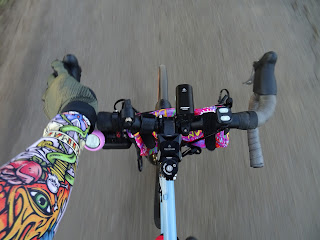I’d returned from the puncture marked ride and decided it was time to give Denise another deep clean, make some gentle tweaks and switch to the fixed gear winter trainer for a little while. This proved an ideal opportunity to put the Green Oil Massive Brush to good use. The added length and softer bristle plot mean it’s effective for all areas of the bike and kind to all surfaces, including paintwork. I’ve always been fond of the original, standard model but the stiffer bristle plot means it’s better suited to wheels, tyres, bar tape and drivetrain components.
As for the fixed, well I need to get some serious miles on the WTB Exposure, especially to assess their wet weather prowess and puncture resistance. Getting the balance between ride quality, reliability and durability is a difficult one. A tyre that delivers a spirited, engaging, and compliant ride but without flatting at the first hint of a flint is no mean feat. I’m generally fond of Schwalbe One 365 but have some quiet reservations about the puncture repelling belt, which only covers the centre strip.
A moot point during a dry summer but wet roads serve as a lubricant. Sure, rolling resistance will drop but the water gives sharps easier passage inside the tyre casing. Anecdotally, others have praised the WTB Exposure’s compliance, speed and puncture resistance, so we’ll see. I’m hoping so. Formative impressions are of a very swift, compliant ride with excellent feedback when cornering on wet roads. A few hundred miles will reveal more. Wetter, characteristically autumnal weather has also presented an opportunity to get miles in with the Madison Flux Waterproof Trail Gloves.
Flat palms are something of a bum steer. Padding density though uniform, is generous, giving excellent defence against low lever vibration without compromising connection with the bars and controls. Silicone detailing is less extensive than some but effective nonetheless and the detailing on thumb and fore finger make for excellent connectivity between touch screen devices. However, rummaging in pockets and operating trusty compact camera is proving trickier- especially on the fly. Thus far, the waterproof backs are doing their thing with similar aplomb and the extensive terry panel is great for taming runny noses etc. Here’s my review of the Cycology Life Behind Bars MTB Gloves Cycology Life Behind Bars MTB Gloves | cycling-not-racing (sevendaycyclist.com)
As or the Shimano MW7, well I’m equally smitten. I remain a major fan of the MW5 but the MW7’s boa closure ensures a precise, almost custom fit. The sole is palpably stiffer, much closer to the RX7, which is particularly apparent when accelerating hard or keeping a high, smooth cadence, especially on the fixed.
I’ve decided to raise the fixed’s saddle height by a centimetre or two and, having removed the post’s binder bolt was amused by how well the Weldtite Carbon Gripper held everything inline! Thankfully, it moved with minimal effort. I added some Mint Assembly Grease to the binder bolt while I was at it.
As for Ursula. Well, Winston and Mario had sorted the repairs, modifications and refinishing. I received a message from Winston asking me to arrange collection before the weekend. Within twenty minutes, I’d organised and paid a courier, passing on the relevant info. Given it was Tuesday, Thursday was the earliest pick up.
I was keen to get the old girl back, for a wealth of obvious reasons. (a) We’ve been through so much and covered so many miles together (b) I was eager to see the repair, refurb and modernisation in the flesh. (c) I wanted to complete the rebuild before winter. Winston had sent camera shot images of the work at various stages. Useful as progress snapshots and welcome but not an accurate representation of the frame finish etc, especially under tungsten light.
Emerging from the box, I was relieved to find she’d survived the parcel destroyers unscathed and was the shade of grey I’d hoped for. The first thing I wanted to do was fill her inner sanctum with corrosion inhibitor. I’d run out of my home brewed “hillbilly Waxoyl” so decided to go for a commercial formula instead.
J Weigel’s Framesaver is another popular, frame specific staple. One I’ve used to good effect in the past. Ditto Pro Gold Steel Frame Protector. However, on this occasion. I spotted some more generic automotive prep designed for door sections and sills, lending itself nicely to KA and Micra duties, too. It’s essentially a wax type formula, so should go the distance, especially since I’ve applied during a dry and relatively mild period.
The other option was to drop some 10W40 motor oil inside the seat tube and using GT85, or similar, to chase it around the frame. I’ve left Ursula sat on old newspaper overnight to absorb any residual and will then get busy with the Zefal Skin Armor ZEFAL SKIN ARMOR ROLL | cycling-not-racing (sevendaycyclist.com) to protect against cable rub and related damage before commencing the big build.



















